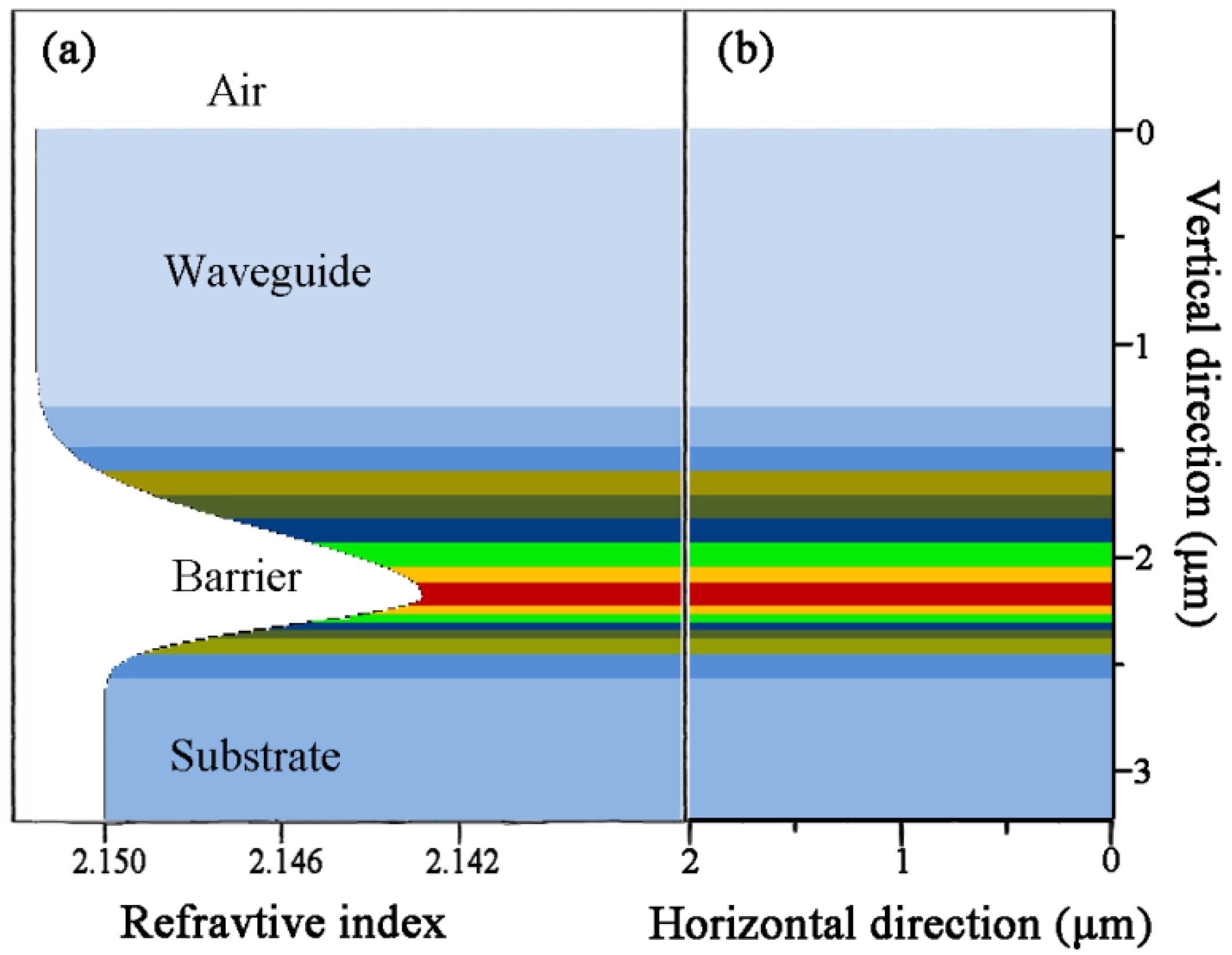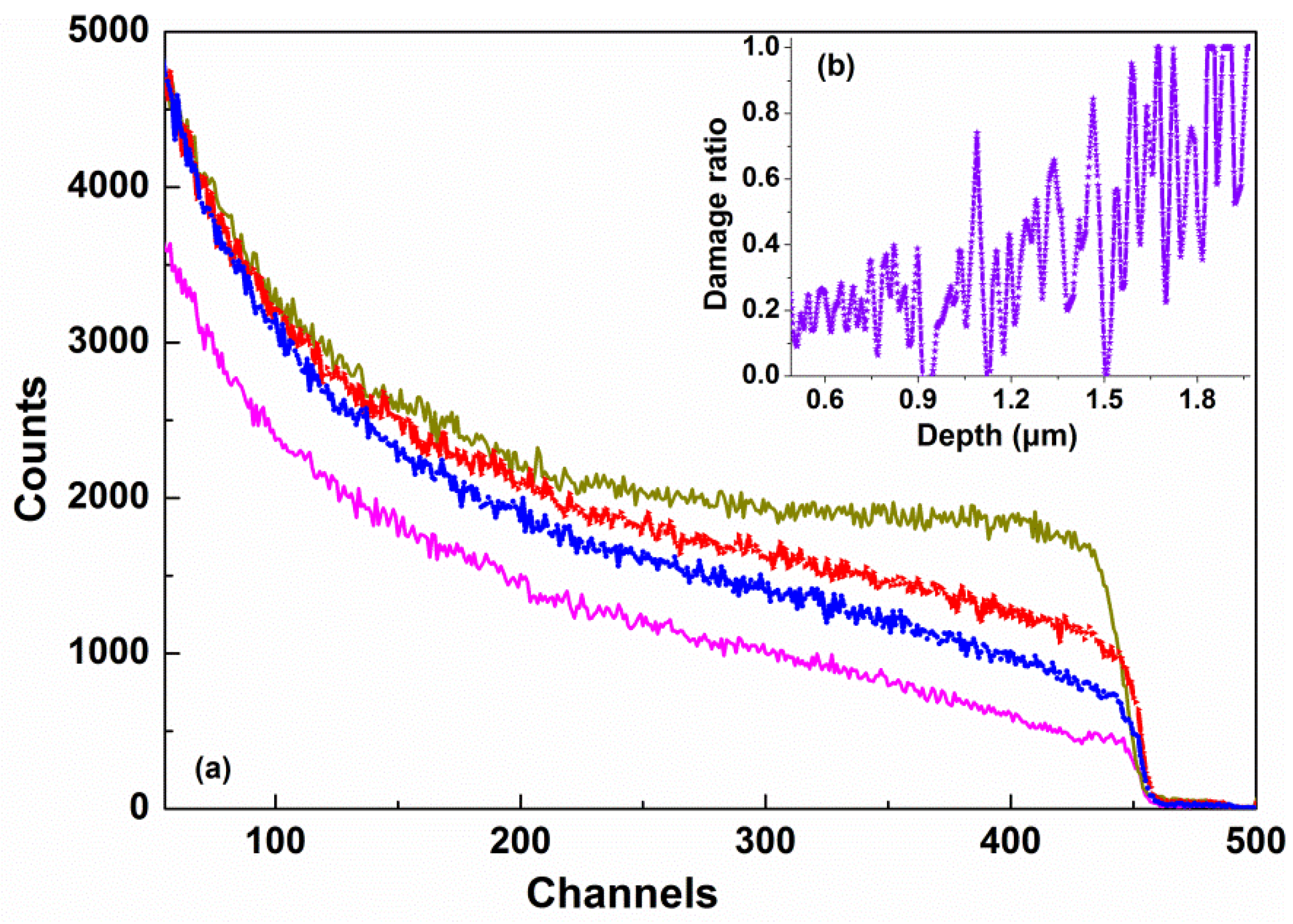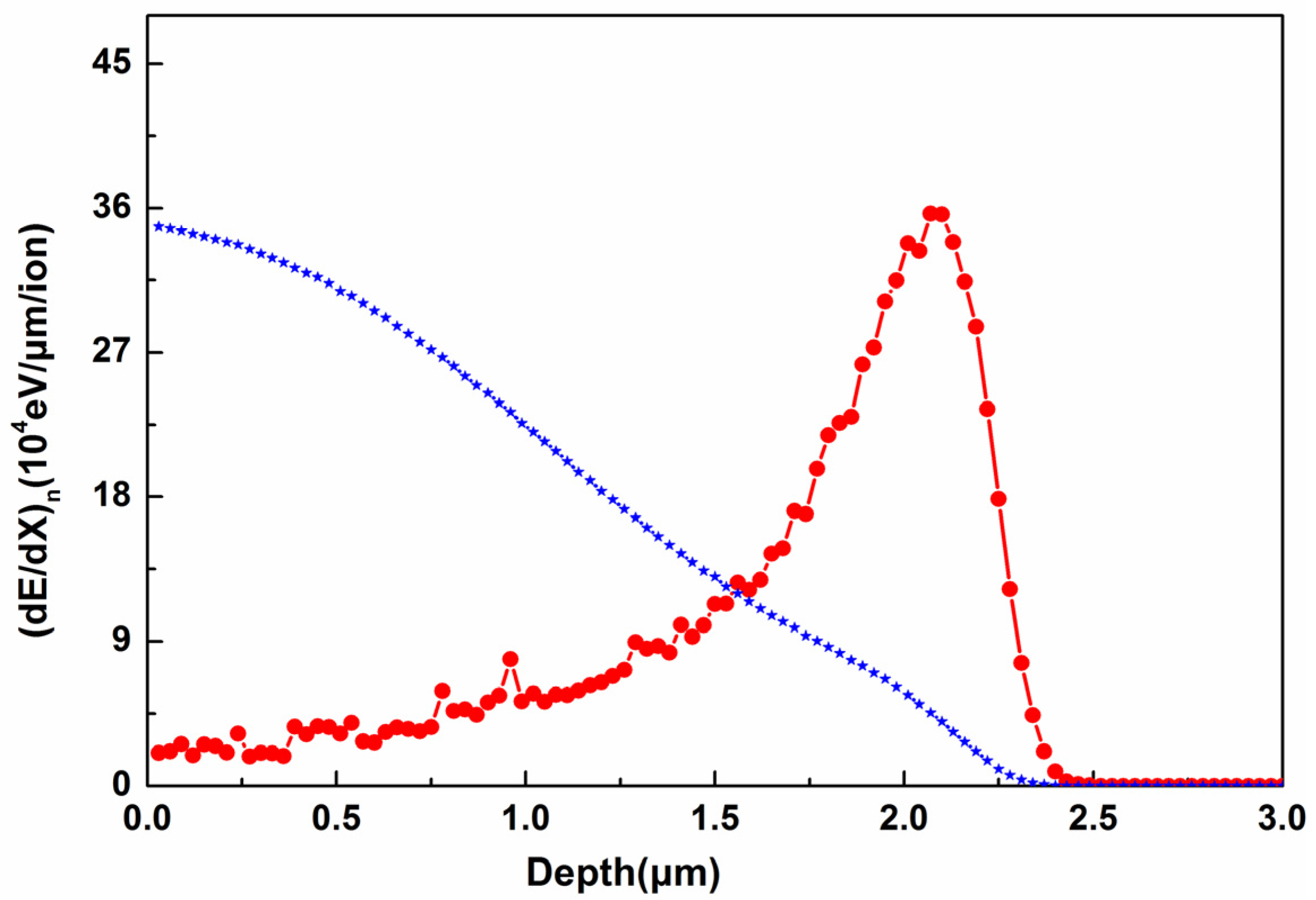Monomode Optical Waveguide Achieved by Lattice Damage in Yttria-Stabilized Zirconia Crystal Induced from Energetic Oxygen Irradiation
Abstract
:1. Introduction
2. Experimental Details
3. Results and Discussion
4. Conclusions
Author Contributions
Funding
Institutional Review Board Statement
Informed Consent Statement
Data Availability Statement
Conflicts of Interest
References
- Vazquez, G.V.; Desirena, H.; De la Rosa, E.; Flores-Romero, E.; Marquez, H.; Rickards, J.; Trejo-Luna, R. Upconversion emission in a carbon-implanted Yb:YAG planar waveguide. Opt. Commun. 2012, 285, 5531–5534. [Google Scholar] [CrossRef]
- Tervonen, A.; West, B.R.; Honkanen, S. Ion-exchanged glass waveguide technology: A review. Opt. Eng. 2011, 50, 071107. [Google Scholar]
- Zhang, F.X.; Velisa, G.; Xue, H.; Sellami, N.; Trautmann, C.; Zhang, Y.; Weber, W.J. Ion irradiation induced strain and structural changes in LiTaO3 perovskite. J. Phys. Condens. Matter 2021, 33, 185402. [Google Scholar] [CrossRef]
- Sellami, N.; Crespillo, M.L.; Xue, H.; Zhang, Y.; Weber, W.J. Role of atomic-level defects and electronic energy loss on amorphization in LiNbO3 single crystals. J. Phys. D Appl. Phys. 2017, 50, 325103. [Google Scholar] [CrossRef]
- Garcia, J.A.; Rodriguez, R.J. Ion implantation techniques for nonelectronic applications. Vacuum 2011, 85, 1125–1129. [Google Scholar] [CrossRef]
- Liu, T.; Kong, W.; Qiao, M.; Cheng, Y. Maintain Raman property in ZnS single crystal waveguide formed by multi-energy He ion implantation at 633 nm. Results Phys. 2018, 11, 822–825. [Google Scholar] [CrossRef]
- Ming, X.; Lu, F.; Yin, J.; Chen, M.; Zhang, S.; Zhao, J.; Liu, X.; Ma, Y.; Liu, X. Waveguide effect in ZnO crystal by He+ ions implantation: Analysis of optical confinement from implant-induced lattice damage. Opt. Commun. 2012, 285, 1225–1228. [Google Scholar] [CrossRef]
- Botzakaki, M.A.; Xanthopoulos, N.; Makarona, E.; Tsamis, C.; Kennou, S.; Ladas, S.; Georga, S.N.; Krontiras, C.A. ALD deposited ZrO2 ultrathin layers on Si and Ge substrates: A multiple technique characterization. Microelectron. Eng. 2013, 112, 208–212. [Google Scholar] [CrossRef]
- Park, B.; Lee, Y.; Oh, I.; Noh, W.; Gatineau, S.; Kim, H. Structural and electrical properties of Ge-doped ZrO2 thin films grown by atomic layer deposition for high-k dielectrics. J. Mater. Sci. 2018, 53, 15237–15245. [Google Scholar] [CrossRef]
- Fan, W.; Wang, Z.Z.; Bai, Y.; Che, J.W.; Wang, R.J.; Ma, F.; Tao, W.Z.; Liang, G.Y. Improved properties of scandia and yttria co-doped zirconia as a potential thermal barrier material for high temperature applications. J. Eur. Ceram. Soc. 2018, 38, 4502–4511. [Google Scholar] [CrossRef]
- Lo, D.; Shi, L.; Wang, J.; Zhang, G.X. Zirconia and zirconia-organically modified silicate distributed feedback waveguide lasers tunable in the visible. Appl. Phys. Lett. 2002, 81, 2707. [Google Scholar] [CrossRef]
- Ye, C.; Wang, J.; Shi, L.; Lo, D. Polarization and threshold energy variation of distributed feedback lasing of oxazine dye in zirzonia waveguides and in solutions. Appl. Phys. B Lasers Opt. 2004, 78, 189–194. [Google Scholar] [CrossRef]
- Sorek, Y.; Zevin, M.; Reisfeld, R.; Hurvits, T.; Ruschin, S. Zirconia and zirconia-ORMOSIL planar waveguides prepared at room temperature. Chem. Mater. 1997, 9, 670–676. [Google Scholar] [CrossRef]
- Chauhan, V.; Gupta, T.; Koratkar, N.; Kumar, R. Studies of the electronic excitation modifications induced by SHI of Au ions in RF sputtered ZrO2 thin films. Mat. Sci. Semicon. Proc. 2018, 88, 262–272. [Google Scholar] [CrossRef]
- Liu, L.; Maeda, K.; Onda, T.; Chen, Z. Microstructure and improved mechanical properties of Al2O3/Ba-β-Al2O3/ZrO2 composites with YSZ addition. J. Eur. Ceram. Soc. 2018, 38, 5113–5121. [Google Scholar] [CrossRef]
- Chen, F.; Wang, J. LDS dye-doped zirconia-organically modified silicate distributed feedback planar waveguide lasers. Appl. Phys. B 2013, 113, 259–264. [Google Scholar] [CrossRef]
- Ye, C.; Wong, K.Y.; He, Y.; Wang, X. Distributed feedback sol-gel zirconia waveguide lasers based on surface relief gratings. Opt. Express 2007, 15, 936–944. [Google Scholar] [CrossRef]
- Ulrich, R.; Torge, R. Measurement of thin film parameters with a prism coupler. Appl. Opt. 1973, 12, 2901–2908. [Google Scholar] [CrossRef] [Green Version]
- Chandler, P.J.; Lama, F.L. A new approach to the determination of planar waveguide profiles by means of a non-stationary mode index calculation. Opt. Acta 1986, 33, 127–143. [Google Scholar] [CrossRef]
- Chung, Y.C.; Dagli, N. An assessment of finite difference beam propagation method. IEEE J. Quantum Electron. 1990, 26, 1335–1339. [Google Scholar] [CrossRef]
- Huang, W.P.; Xu, C.L. Simulation of three-dimensional optical waveguides by a full-vector beam propagation method. IEEE J. Quantum Electron. 1993, 29, 2639–2649. [Google Scholar] [CrossRef]
- Hadley, G.R. Transparent boundary condition for the beam propagation method. IEEE J. Quantum Electron. 1992, 28, 363–370. [Google Scholar] [CrossRef] [Green Version]
- Sato, K.; Fujino, Y.; Yamaguchi, S.; Naramoto, H.; Ozawa, K. Ion channeling studies of C+ irradiated TiC single crystals. Nucl. Instrum. Methods Phys. Res. B 1990, 47, 421–426. [Google Scholar] [CrossRef]
- Feldman, L.C.; Rodgers, J.M. Depth profiles of the lattice disorder resulting from ion bombardment of silicon single crystals. J. Appl. Phys. 1970, 41, 3776–3782. [Google Scholar] [CrossRef]
- Ziegler, J.F. Interactions of Ions with Matter. Available online: www.srim.org (accessed on 1 August 2021).
- Ziegler, J.F.; Ziegler, M.D.; Biersack, J.P. SRIM–The stopping and range of ions in matter. Nucl. Instrum. Methods Phys. Res. Sect. B 2010, 268, 1818–1823. [Google Scholar] [CrossRef] [Green Version]
- Olivares, J.; García-Navarro, A.; Méndez, A.; Agulló-López, F.; García, G. Novel optical waveguides by in-depth controlled electronic damage with swift ions. Nucl. Instrum. Methods Phys. Res. B 2007, 257, 765–770. [Google Scholar] [CrossRef]
- Peithmann, K.; Zamani-meymian, M.R.; Haaks, M.; Maier, K. Fabrication of embedded waveguides in lithiumniobate crystals by radiation damage. Appl. Phys. B 2006, 82, 419–422. [Google Scholar] [CrossRef]






Publisher’s Note: MDPI stays neutral with regard to jurisdictional claims in published maps and institutional affiliations. |
© 2021 by the authors. Licensee MDPI, Basel, Switzerland. This article is an open access article distributed under the terms and conditions of the Creative Commons Attribution (CC BY) license (https://creativecommons.org/licenses/by/4.0/).
Share and Cite
Ming, X.; Wang, Z.; Zhang, Y. Monomode Optical Waveguide Achieved by Lattice Damage in Yttria-Stabilized Zirconia Crystal Induced from Energetic Oxygen Irradiation. Appl. Sci. 2021, 11, 10750. https://doi.org/10.3390/app112210750
Ming X, Wang Z, Zhang Y. Monomode Optical Waveguide Achieved by Lattice Damage in Yttria-Stabilized Zirconia Crystal Induced from Energetic Oxygen Irradiation. Applied Sciences. 2021; 11(22):10750. https://doi.org/10.3390/app112210750
Chicago/Turabian StyleMing, Xianbing, Zekun Wang, and Yi Zhang. 2021. "Monomode Optical Waveguide Achieved by Lattice Damage in Yttria-Stabilized Zirconia Crystal Induced from Energetic Oxygen Irradiation" Applied Sciences 11, no. 22: 10750. https://doi.org/10.3390/app112210750
APA StyleMing, X., Wang, Z., & Zhang, Y. (2021). Monomode Optical Waveguide Achieved by Lattice Damage in Yttria-Stabilized Zirconia Crystal Induced from Energetic Oxygen Irradiation. Applied Sciences, 11(22), 10750. https://doi.org/10.3390/app112210750




